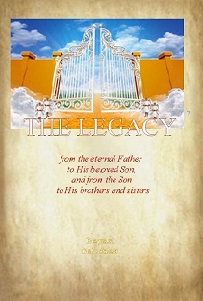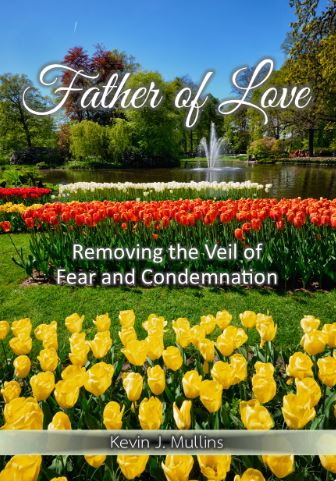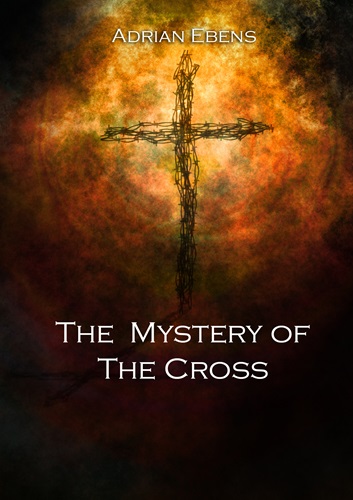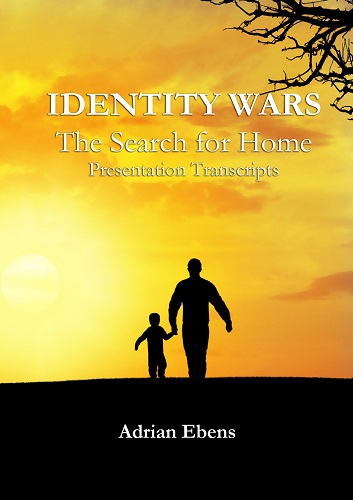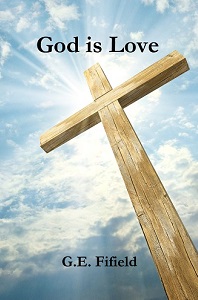The Threefold Nature of the Law
As a younger Bible student, one of the reasons I believed the Trinity was because of the clear Bible evidence that there were Father, Son and Holy Spirit. As there were three entities described and I simply assumed the relationship between these three entities was co-equal. I never questioned the nature of the relationship until recently.
As I began to study the Scriptures more closely I began to see that the Son came forth from the Father and the Spirit of God flowed forth from the Father and the Son. There is one source that begets the Son and within this Father and Son relationship of Headship and Submission, a fountain is established to pour forth the Spirit of God and establish the rulership of the Father and Son in the hearts of all creation.
Does this pattern help us to understand the relationship that exists within the Law of God? In chapter 3 of my book Divine Pattern I discuss the principles of the threefold cord.
Ecc 4:12 And if one prevail against him, two shall withstand him; and a threefold cord is not quickly broken.
From the beginning of time it was the duty of the patriarchs to teach the law of God to his family and administer the law in his home. Notice how Ellen White describes this.
At the beginning, the father was constituted [1] priest and [2] magistrate of his own family. Then came the patriarchal rule,which was like that of the family, but extended over a greater number. When Israel became a distinct people, the twelve tribes, springing from the twelve sons of Jacob, had each a leader. These leaders, or elders, were assembled whenever any matter that pertained to the general interest was to be settled. [1] The high priest was the visible representative of Christ, the Redeemer of his people. When the Hebrews settled in Canaan, [2] judges were appointed, who resembled governors. These rulers were invested with authority to declare war and proclaim peace for the nation; but God was still the recognized king of Israel, and he continued to reveal his will to these chosen leaders, and to manifest through them his power. Signs of the Times, July 13, 1882. (Square brackets added)
The three entities that we see operating in Scripture is as follows
|
1. Prophet |
Speaks the Law of God. Deut 18:18-19 |
|
2. Priest |
Teaches the word of the Prophets that contained the law and the gospel. Ezra 7:11 |
|
3. Judge (King) |
Administers rewards and punishments regarding the law. Deut 17:18-20 |
It is easy to derive from these three offices three aspects to the law
|
1. Prophet |
Moral Law |
Tables of the Law |
|
2. Priest |
Ceremonial Law (Teaching Law and Gospel) |
Book of the Law |
|
3. Judge (King) |
Civil or Judicial Law (Teach Law) |
Book of the Law |
The Ceremonial expression of the Law reveals God’s process of restoring man to the Law (character) of God. It is a process of writing the Law (character) on the heart. The writing process is revealed in the gospel and the result is the whole Law (character) of God written in the heart. This process is revealed in the Sanctuary and its services. The demonstration of love revealed in the Sanctuary services reveals the love that is at the centre of the Law (character) of God. Eze 36:26,27, Ex 25:8,9, Rom 13:8, Matt 22:37-40.
The Civil expression of the Law involved judgements on those who violated the Law. It is the rod of correction and acts as a warning to those who walk contrary to the Law of God. People would learn the judgements in order to understand the will of God. It also involved statutes for the times of worship that affected Israel corporately. See Ex 21-23 as an example.
Now the question that arises is how do these three relate to each other and does our understanding of the three great powers from heaven help us with this question?
If we study Adventist history we see clear evidence of the threefold nature of the law revealed. It is also interesting to learn how the pioneers perceived how these laws related to each other and where these ideas came from.
As a people, we believe that there are two laws, or systems of law : ( 1.) The moral law and the principles of moral duty which grow out of it; (2.) The ceremonial law, embracing the typical remedial system pointing forward to Christ, and the civil laws growing out of the special relation existing between God and the Jewish people to the cross. We hold the former to be ever binding upon man, while the latter passed away. G.I Butler, Law in Book of Galatians (1886) p 7.
As this law has sometimes been confounded with other laws, to which the foregoing declarations of Scripture will not apply, it will be in place to notice the distinction of laws. The system (not the law) under which the people of God lived in the past dispensation was complex; its elements were moral, civil, and ceremonial. The moral was the basis of all, existing prior to, and independent of, the others, and was from the beginning the standard of duty to God and to our fellow-men. The civil enforced the [66] moral, especially in men's relations to their fellowmen, making application of its principles to everyday life. The ceremonial expiated the violations of the moral, and had especial reference to their relations to God. But both the ceremonial and civil were merely typical, looking forward to the priesthood of Christ and to his kingdom; and therefore illustrated the true relation we sustain under Christ to the law of God, the moral rule, in this and the future dispensation. J.H Waggoner, The Atonement (1884) p 65,66.
"We answer, that there should be a distinguishing between the civil and the moral law. The moral law was binding on all, down to the end of time; but the civil and ceremonial laws were not, because Christ was to do them away in introducing the new dispensation." "But the objector may ask, 'Was not the moral law also given by Moses?' It was; but it was 'written, on tables of stone, with the finger of God,' (Ex. xxxi, 18), emphatically because it was more important, reaching down to the end of time." "But what gives a distinguishing feature to the ten commandments, or moral law, is, that Christ has never nullified it but sanctioned it, by teaching that neither jot nor tittle should "pass from the law till all be fulfilled.'" M.E Cornell RH Aug 15, 1865
If we study the typical pioneer understanding of how these three laws related to each other, the consistent theme is that the moral Law was eternal and binding upon all generations but the ceremonial and civil were temporary and ceased at the cross. This idea was prevelant in several protestant denominations that held to the 1647 Westminster Confession of Faith which states concerning the Law:
III. Besides this law, commonly called moral, God was pleased to give to the people of Israel, as a church under age, ceremonial laws, containing several typical ordinances, partly of worship, prefiguring Christ, His graces, actions, sufferings, and benefits;[4] and partly, holding forth divers instructions of moral duties.[5] All which ceremonial laws are now abrogated, under the New Testament.[6]
IV. To them also, as a body politic, He gave sundry judicial laws, which expired together with the State of that people; not obliging under any now, further than the general equity thereof may require.[7]
V. The moral law does forever bind all, as well justified persons as others, to the obedience thereof;[8] and that, not only in regard of the matter contained in it, but also in respect of the authority of God the Creator, who gave it.[9] Neither does Christ, in the Gospel, any way dissolve, but much strengthen this obligation.[10]
If we trace this idea further into history we find the following:
Traditional Reformed theology has distinguished God’s law revealed in the Old Testament Scriptures into three parts, moral, ceremonial and civil (or judicial).It teaches that the moral element in the law, focused in the ten commandments, is of permanent application, while the ceremonial and civil elements were for the duration of the Old Testament economy only. The ceremonial was a shadow of Christ which became obsolete with his coming, and the civil a model of legal arrangements for any society, though not of such a status as to demand exact replication. ...
In the final chapter of The Institutes Calvin writes:
“We must attend to the well-known division which distributes the whole law of God, as promulgated by Moses, into the moral, the ceremonial, and the judicial law.” Calvin, J, Institutes of the Christian Religion, Translated by Henry Beveridge, James Clark & Co., 1962, Volume 2, Book 4, Chapter 20, Section 14, page 663
Similarly, Francis Turretin, one of Calvin’s successors at Geneva in the middle years of the seventeenth century, has written:
“The law given by Moses is usually distinguished into three species: moral (treating of morals or of perpetual duties towards God and our neighbour); ceremonial (of the ceremonies or rites about the sacred things to be observed under the Old Testament); and civil (constituting the civil government of the Israelite people).” Turretin, F, Institutes of Elenctic Theology, 11.24.1
Two years after Turretin’s death the 1689 Baptist Confession incorporated reference to this threefold division of the law. Chapter 19 of the Confession was entitled Of the Law of God. It was taken over with only minor modifications from the Westminster Confession of 1646, which represents the distilled essence of Puritan theology. While recognising the primacy of the moral law, the Puritan confessions speak also of the ceremonial laws governing the worship of the people of Israel and prefiguring Christ, and the judicial laws governing the political life of Israel.
Although the threefold division of the law is associated with Reformed theology, and has even been described as ‘the cornerstone of Reformed orthodoxy’, it would be a mistake to assume that these distinctions were novelties at the time of the Reformation. Turretin notes that the threefold division is ‘usual’. Calvin speaks of ‘the well known division’. I J Hesselink traces this division back to the medieval scholastic theologian, Thomas Aquinas. It was around 1270 that Aquinas wrote:
“We must therefore distinguish three kinds of precept in the Old Law; viz. ‘moral’ precepts, which are dictated by the natural law; ‘ceremonial’ precepts, which are determinations of the Divine worship; and ‘judicial’ precepts, which are determinations of the justice to be maintained among men.” Thomas Aquinas, Summa Theologica, 2a, Question 99, Article 4
Despite Hesselink’s claim that this threefold division originated with Aquinas, it seems prima facie probable that the idea (even if not the precise terminology) has a longer pedigree. Calvin refers to ‘the ancients who adopted this division’. Such a turn of phrase suggests that he was looking back further than the thirteenth century. (Calvin J, Op cit, Volume 2, Book 4, Chapter 20, Section 14). In his Summa Theologica Aquinas refers frequently to Augustine. Distinctions within the law were already familiar by the time of this fifth-century theologian, although he operates with a twofold rather than a threefold division.
Quoted from http://www.christian.org.uk/wp-content/downloads/the-threefold-division-of-the-law.pdf Jonathan Bayes, The Threefold Division of the Law,
When we consider the theological foundations of men like Aquinas and Augustine, is it safe to develop our understandings of this threefold law upon their theological framework? Considering the Trinitarian conception of God that both Catholic and Reformed theologians held, are we on safe ground when expressing a relationship that removes two of the three parts of the law?
When we consider the Father and the Son and their Spirit we observe a principle of amplification. The Son comes forth from the Father and from Father and Son the Spirit flows forth into the universe. Due to the fact of there being one source, there naturally follows an amplification in the entities of Son and Spirit. However if we have three entities each forming a source then when one person is operating, then the other two are not the source and run the risk of being obscured. This is reflected in the natural trend towards Modalism where One God features One person at a time in in His work. Therefore within the Trinity, there is not an amplification principle but a prominence principle at the expense of the other two.
Is it a coincidence that these three elements of the law were written on two distinct documents that express one law?Is the Law of God indeed made in the image of God? If mankind was made in the image of God in form and feature then would not the law of God also be an image in form and feature?
In the beginning, man was created in the likeness of God, not only in character, but in form and feature. Great Controversy p 645.
|
God |
Law |
Quotes |
|
Father |
Moral Law – The Source (The Truth) |
The Ancient of Days is God the Father. …. It is He, the source of all being, and the fountain of all law. GC 479 |
|
Son |
Ceremonial Law – The Way |
Psa 77:13 Thy way, O God, is in the sanctuary: who is so great a God as our God? John 14:6 Jesus saith unto him, I am the way, the truth, and the life: no man cometh unto the Father, but by me. |
|
Spirit |
Civil Law – Ruling in the hearts of all creation (The Life) |
John 6:63 It is the spirit that quickeneth; the flesh profiteth nothing: the words that I speak unto you, they are spirit, and they are life. Those who are truly connected with Him cannot be at variance with one another. His Spirit ruling in the heart will create harmony, love, and unity. 5T 28 If the principles of God's law rule in our hearts, we shall have the spirit of Christ. LP 232. |
As all the fullness of the Godhead dwells in the Son of God (Col 2:9), indeed He is the Way, the Truth and the Life. Therefore God even the Father has given the Son a name above every name and in Him all things consist.
Indeed if we are baptised in this name we are anointed with all the fullness of God. In the person of Jesus is Prophet, Priest and King. Is there evidence that these three offices occur in a process of amplification?
Notice how A.T Jones speaks about the offices of Prophet, Priest and King.
And to us the consideration of Him in these offices in their order is essential. We must consider Him in His office as prophet, not only in order that we may be taught by Him who spake as never man spake, but also that we shall be able properly to consider Him in His office as priest. And we must consider Him in His office as priest, not only that we may have the infinite benefit of His priesthood, but also that we shall be prepared for what we are to be. For it is written: "They shall be priests of God and of Christ, and shall reign with Him a thousand years." Rev. 20:6.
And having considered Him in His office of prophet as preparatory to our properly considering Him in His office as priest, it is essential that we consider Him in His office as priest in order that we shall be able to consider Him in His office as king; that is, in order that we shall be with Him there and reign with Him there. A.T Jones, Consecrated Way 1905, page 8.
A.T Jones emphasises a progression of thought from Prophet to Priest to King in the person of Jesus. This is an amplification process. These are not three co-equal offices but are a procession and amplification of offices.
Now with this thought in mind I want to reveal a Divine Pattern relationship between them.
|
Office |
Law |
Type I |
Type II |
Antitype |
|
Prophet |
Moral – Truth |
Abraham. Gen 12:1-3 |
Moses Deut 34:10 |
Christ Messiah, promised the kingdom. Matt 28:18, Col 1:13 |
|
Priest |
Ceremonial - Way |
Abraham Gen 12:7 |
Aaron Ex 28:1 |
Christ as Priest in Heaven. Father of faith. Heb 12:2 |
|
King |
Civil - Life |
Abraham Gen 14:14-17 |
David 2 Sam 5:3 |
Christ, Son of David as King over all. Rev 19:16 |
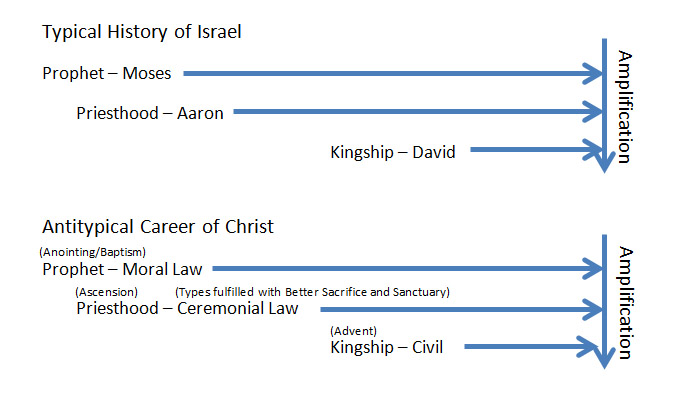
When Christ was here on earth he proclaimed as a prophet the law of His Father. We are now living during the time of Christ’s office of Priest. The law concerning His priestly work is now in full force and we receive His mediation for the law that Christ proclaimed while here on earth. We have a living way to the Father. We are also learning the laws of the coming kingdom for when the Son of David sits on His Father’s throne, when the civil law will once again be fully in operation and the Spirit of God will rule in our hearts. During this time of the Gentiles, the diadem would be overturned until Christ comes the second time.
Eze 21:25-27 And thou, profane wicked prince of Israel, whose day is come, when iniquity shall have an end, (26) Thus saith the Lord GOD; Remove the diadem, and take off the crown: this shall not be the same: exalt him that is low, and abase him that is high. (27) I will overturn, overturn, overturn, it: and it shall be no more, until he come whose right it is; and I will give it him.
The critical point is the relationship between type and antitype. Christ as the Prophet that would come was an amplification and full expression of all that Moses wrote. The ceremonial system of Israel has found its full expression in the ministry of Christ. At this very time the priestly ministry of Jesus as reflected in the ceremonial law is in full antitypical force. We are now preparing ourselves for the reign of the Son of David and are learning the ways of this kingdom which have their foundation in the kingdom of David.
Another thought to consider is that the roles of Prophet Priest and King were residing in one person in Abraham. This birthright of Abraham was divided amongst the sons of Jacob. When Christ came all these offices returned to Him in one person.
If we can take this one step further, we see that before Christ came, Abraham was the visible image of Christ who was invisible to human sight in heaven. As an image of Christ, God poured all His blessings into the world through one person, Abraham thus revealing a divine pattern relationship. See the article Divine Pattern – Key to the Law for more on these principles. When the birthright was divided amongst the sons of Jacob, the offices manifested in different tribes. The role of prophet could come from any tribe but the role of Priest remained with Levi and the Kingship remained with Judah. It was through the Spirit of Christ that the offices of Moses, Aaron and David were established. From these offices in the Old Testament, Christ came into the world to fully manifest what He had established through them.
So in the Old Testament the Divine Pattern was:
|
Divine Pattern |
Prophet |
Priest |
King |
|
Source (Heaven) |
Christ |
Christ |
Christ |
|
Channel (Earth) |
Moses |
Aaron |
David |
Christ was the Lamb slain from the foundation of the world and Aaron was simply the visible manifestation of what Christ was in Heaven. The everlasting covenant made with Adam, Noah and Abraham was always upon better promises. The sacrificial Sanctuary system that developed was merely a visible image or pattern of what was already occurring in Heaven.
Having established the visible earthly system through Moses, Aaron and David, this system then became the foundation upon which Christ would now fully express these offices.
|
Divine Pattern |
Prophet |
Priest |
King |
|
Source (Old Testament) |
Moses |
Aaron |
David |
|
Channel (New Testament) |
Christ |
Christ |
Christ |
In light of the Divine Pattern we can see that indeed Christ did not come to destroy the law but rather fully express it and make it full. I realise we have canvased several points in this article and it obviously needs a fuller expression!
If we base the relationship of the three Laws found in Scripture upon the principles of the Three great Powers of Heaven as well as the three progressive offices of Christ, I believe we have a very different understanding of the law than that based on the Trinity, Aquinas and Augustine.

